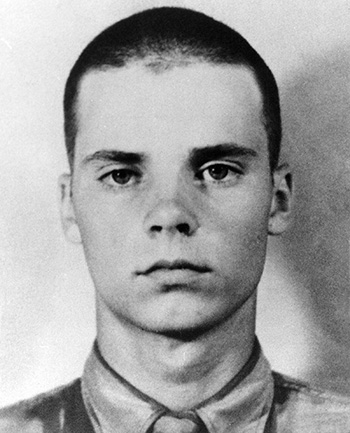Rick Mausert was born on May 1, 1930, in Cambridge, New York. He enlisted in the U.S. Marine Corps on June 21, 1948, and then completed basic training at MCRD Parris Island, South Carolina, in September 1948. PFC Mausert next attended Infantry training and Field Radio Operator training at Camp Lejeune, North Carolina, before serving with Marine Air Control Group One (MACG-1) with the 2nd Marine Aircraft Wing at MCAS Cherry Point, North Carolina, until November 1950. He then served with Headquarters & Service Company, 1st Battalion, 2nd Marine Regiment of the 2nd Marine Division at Camp Lejeune, North Carolina, from November 1950 to June 1951, followed by service with the 1st Air Naval Gunfire Liaison Company (ANGLICO), Fleet Marine Force Pacific, at Pearl Harbor, Hawaii, from June to July 1951. Sgt Mausert joined B Company, 2nd Platoon, 1st Battalion, 7th Marine Regiment of the 1st Marine Division in Korea in July 1951, and he was Killed in Action during a mission for which he would later be awarded the Medal of Honor on September 12, 1951. He was originally buried at the United Nations Military Cemetery in Tanggok, Korea, but he was then moved to Arlington National Cemetery and buried on January 3, 1952. Sgt Mausert's mother was presented his Medal of Honor posthumously on September 4, 1952.
His Medal of Honor Citation reads:
For conspicuous gallantry and intrepidity at the risk of his life above and beyond the call of duty while serving as a squad leader in Company B, in action against enemy aggressor forces. With his company pinned down and suffering heavy casualties under murderous machine-gun, rifle, artillery, and mortar fire laid down from heavily fortified, deeply entrenched hostile strongholds on Hill 673, Sgt. Mausert unhesitatingly left his covered position and ran through a heavily mined and fire-swept area to bring back two critically wounded men to the comparative safety of the lines. Staunchly refusing evacuation despite a painful head wound sustained during his voluntary act, he insisted on remaining with his squad and, with his platoon ordered into the assault moments later, took the point position and led his men in a furious bayonet charge against the first of a literally impregnable series of bunkers. Stunned and knocked to the ground when another bullet struck his helmet, he regained his feet and resumed his drive, personally silencing the machine gun and leading his men in eliminating several other emplacements in the area. Promptly reorganizing his unit for a renewed fight to the final objective on top of the ridge, Sgt. Mausert boldly left his position when the enemy's fire gained momentum and, making a target of himself, boldly advanced alone into the face of the machine gun, drawing the fire away from his men and enabling them to move into position to assault. Again severely wounded when the enemy's fire found its mark, he still refused aid and continued spearheading the assault to the topmost machine-gun nest and bunkers, the last bulwark of the fanatic aggressors. Leaping into the wall of fire, he destroyed another machine gun with grenades before he was mortally wounded by bursting grenades and machine-gun fire. Stouthearted and indomitable, Sgt. Mausert, by his fortitude, great personal valor, and extraordinary heroism in the face of almost certain death, had inspired his men to sweep on, overrun, and finally secure the objective. His unyielding courage throughout reflects the highest credit upon himself and the U.S. Naval Service. He gallantly gave his life for his country.
|



